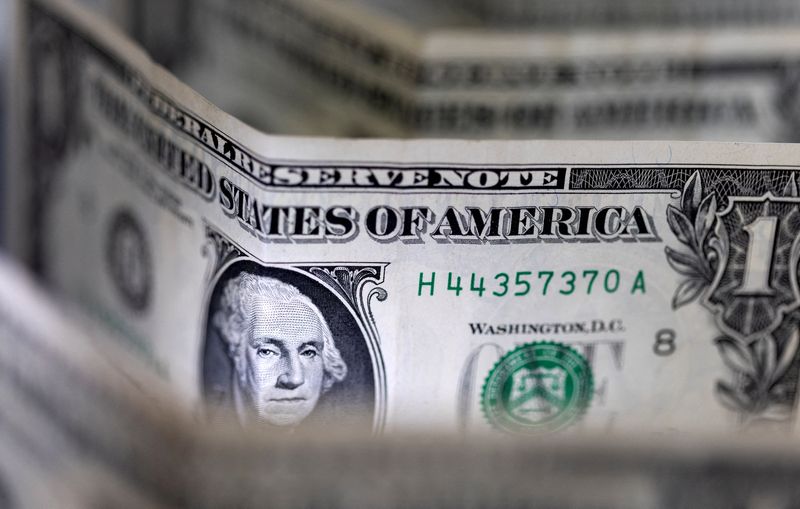Forex
Dollar soars with U.S. economy on solid ground; sterling slumps

© Reuters
Investing.com – The U.S. dollar rose sharply in European trade Friday, after the surprise cut by the Swiss National Bank cast the Federal Reserve in a more hawkish light.
At 04:00 ET (09:00 GMT), the Dollar Index, which tracks the greenback against a basket of six other currencies, traded 0.4% higher at 104.085, near a three-week high and on track for a second week of gains.
U.S. economy on solid footing
The delivered the biggest surprise of a week filled with central bank meetings, cutting interest rates and citing the strength of the franc as a reason.
The Swiss franc, the best performing G10 currency of 2023, dropped more than 1% overnight, and has continued to fall Friday, with up 0.4% to 0.9009, rising closer to parity.
This move has prompted traders to reassess the Fed’s likely future actions, in the wake of this week’s FOMC meeting where officials reaffirmed the likelihood of three interest rate cuts this year if the economic data allows.
The U.S. central bank also sharply upgraded its outlook for growth in 2024, and Thursday’s data suggested the U.S. economy remained on solid footing after the number of Americans filing for unemployment benefits unexpectedly fell last week, while sales of previously owned increased by the most in a year in February.
This suggests the Fed doesn’t need to be in any hurry to cut rates going forward.
That said, “the jump in the dollar appears overdone,” said analysts at ING, in a note.
“The Federal Reserve sent a rather clear message earlier this week: some resilience in activity data won’t be a barrier to cutting as long as inflation shows downward momentum.”
BOE rate cut expectations not “unreasonable”
In Europe, fell 0.5% to 1.2588, falling to a one-month low after the left interest rates unchanged on Thursday, but two MPC members dropped their calls for a rate hike in the face of easing inflation.
Expectations of interest rate cuts this year were not “unreasonable”, according to Bank of England Governor Andrew Bailey, the Financial Times reported on Friday.
“Markets are largely reading this as an acknowledgement that cuts aren’t too far away,” ING added, and now increasingly convinced the BoE will start easing in June (20bp priced in), along with starting to speculate on a May move (7bp priced in).”
traded 0.4% lower to 1.0814, with eurozone activity data continuing to paint a grim picture for the region’s manufacturing outlook.
The European Central Bank may be in a position to cut interest rates before the summer recess, possibly in June, as inflation is on its ways back to the bank’s 2% target, Bundesbank President Joachim Nagel said on Friday.
The comments add Nagel to a long list of policymakers seemingly backing a cut in June and suggest the ECB will be the second major central bank after its Swiss counterpart to start unwinding a record string of rate hikes.
Yen close to four-month low
traded marginally lower at 151.59, close to its highest level in four months, with the yen nursing steep overnight losses.
rose 0.2% to 7.2297, crossing the 7.2 level for the first time since November 2023, following reports that the PBOC was selling dollars and buying yuan from the open market to support the Chinese currency.
dropped 0.8% to 0.6515, with risk sentiment taking a hit.

 Forex3 years ago
Forex3 years agoForex Today: the dollar is gaining strength amid gloomy sentiment at the start of the Fed’s week

 Forex3 years ago
Forex3 years agoUnbiased review of Pocket Option broker

 Forex3 years ago
Forex3 years agoDollar to pound sterling exchange rate today: Pound plummeted to its lowest since 1985

 Forex3 years ago
Forex3 years agoHow is the Australian dollar doing today?

 Cryptocurrency3 years ago
Cryptocurrency3 years agoWhat happened in the crypto market – current events today

 World3 years ago
World3 years agoWhy are modern video games an art form?

 Commodities3 years ago
Commodities3 years agoCopper continues to fall in price on expectations of lower demand in China

 Economy3 years ago
Economy3 years agoCrude oil tankers double in price due to EU anti-Russian sanctions























